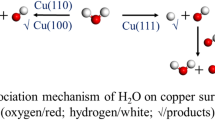Abstract
A DFT quantum-chemical study of NO adsorption and reactivity on the Cu20 and Cu16 metal clusters showed that only the molecular form of NO is stabilized on the copper surface. The heat of monomolecular adsorption was calculated to be ΔH m = −49.9 kJ/mol, while dissociative adsorption of NO is energetically unfavorable, ΔH d = + 15.7 kJ/mol, and dissociation demands a very high activation energy, E a = + 125.4 kJ/mol. Because of the absence of NO dissociation on the copper surface, the formation mechanism of the reduction products, N2 and N2O, is debatable since the surface reaction ultimately leads to N-O bond cleavage. As the reaction occurs with a very low activation energy, E a = 7.3 kJ/mol, interpretation of the NO direct reduction mechanism is both an important and intriguing problem because the binding energy in the NO molecule is high (630 kJ/mol) and the experimental studies revealed only physically adsorbed forms on the copper surface. It was found that the formation mechanism of the N2 and N2O reduction products involves formation (on the copper surface) of the (OadN-NOad) dimer intermediate that is chemisorbed via the oxygen atoms and characterized by a stable N-N bond (r N-N ∼1.3 Å). The N-N binding between the adsorbed NO molecules occurs through electron-accepting interaction between the oxygen atoms in NO and the metal atoms on the “defective” copper surface. The electronic structure of the (OadN-NOad) surface dimer is characterized by excess electron density (ON-NO)δ− and high reactivity in N-Oad bond dissociation. The calculated activation energy of the destruction of the chemisorbed intermediate (OadN-NOad) is very low (E a = 5–10 kJ/mol), which shows that it is kinetically unstable against the instantaneous release of the N2 and N2O reduction products into the gas phase and cannot be identified by modern experimental methods of metal surface studies. At the same time, on the MgO surface and in the individual (Ph3P)2Pt(O2N2) complex, a stable (OadN-NOad) dimer was revealed experimentally.
Similar content being viewed by others
References
W. A. Brown and D. A. King, J. Phys. Chem. B, 104, No. 12, 2578–595 (2000).
S. Haq, A. Carew, and R. Raval, J. Catal., 221, No. 1, 204–212 (2004).
R. Burch, S. T. Daniells, and P. Hu, J. Chem. Phys., 121, No. 6, 2737–2745(2004).
W. A. Brown, P. Gardner, and D. A. King, J. Phys. Chem., 99, No. 18, 7065–7074 (1995).
A. Snis and I. Panas, Chem. Phys., 221, 1–10 (1997).
I. I. Zakharov, V. F. Anufrienko, O. I. Zakharova, et al., J. Struct. Chem., 46, No. 2, 2123–219 (2005).
N. G. Maksimov, V. K. Dudchenko, V. F. Anufrienko, et al., Teor. Éksp. Khim., 14, No. 1, 53–58 (1978).
I. I. Zakharov, Z. R. Ismagilov, S. Ph. Ruzankin, et al., J. Phys. Chem. C, 111, No. 7, 3080–3089 (2007).
L. Curruti, E. Modon, E. Guglielminotti, and E. Borello, J. Chem. Soc., Faraday Trans. I, 7, No. 4, 729 (1974).
R. Ramprasad, K. C. Hass, W. F. Schneider, and J. B. Adams, J. Phys. Chem. B, 101, No. 35, 6903–6913 (1997).
Y. Zhang, Y. Sun, A. Cao, et al., J. Mol. Struct. (Theochem), 623, 245–251 (2003).
S. Bhaduri, B. F. G. Jonson, A. Pickard, et al., J. Chem. Soc., Chem. Commun., 1977, 354–356 (1977).
M. J. Frisch, G. W. Trucks, H. B. Schlegel, et al., Gaussian 92/DFT, Revision G.2, Gaussian Inc., Pittsburgh (1993).
R. J. Hay and W. R. Wadt, J. Chem. Phys., 82, 270–310 (1985).
Density Functional Theory, in: NATO ASI Series, Series B: Physics, E. K. U. Gross and R. M. Drezier (eds.), Plenum, New York (1995).
A. D. Becke, J. Chem. Phys., 98, 5648–5652 (1993).
C. Lee, W. Yang, and R. G. Parr, Phys. Rev. B, 37, 785–797 (1988).
I. I. Zakharov, I. N. Shapovalova, O. I. Zakharova, et al., J. Struct. Chem., 42, No. 6, 888–893 (2001).
A. Bogicevic and K. C. Hass, Surf. Sci., 506, L237–L242 (2000).
M. Perez-Jigato, D. A. King, and A. Yochimori, Chem. Phys. Lett., 300, 639–644 (1999).
C. G. P. M. Bernardo and J. A. N. F. Gomes, J. Mol. Struct. (Theochem), 629, No. 1, 251–261 (2003).
M. J. S. Spencer and G. L. Nyberg, Mol. Simul., 28, Nos. 8/9, 807–825 (2004).
M. A. Karolewski, Nucl. Instr. Meth., B254, 59–68 (2007).
D. A. Trubitsyn, V. A. Zakharov, and I. I. Zakharov, J. Mol. Catal. A: Chem., 270, 164–170 (2007).
M. Iwamoto, H. Yahiro, Y. Mine, and S. Kagawa, Chem. Lett., No. 2, 213–216 (1989).
M. Iwamoto and H. Hamada, Catal. Today, 10, 57–71 (1991).
S. N. Orlik, Teor. Éksp. Khim., 37, No. 3, 133–157 (2001).
Author information
Authors and Affiliations
Corresponding author
Additional information
__________
Translated from Zhurnal Strukturnoi Khimii, Vol. 48, Supplement, pp. S155–S168, 2007.
Original Russian Text Copyright © 2007 by I. I. Zakharov, A. V. Suvorin, A. I. K lbasin, and O. I. Zakharova
Rights and permissions
About this article
Cite this article
Zakharov, I.I., Suvorin, A.V., Kolbasin, A.I. et al. DFT quantum-chemical calculations of nitrogen oxide chemisorption and reactivity on the Cu(100) surface. J Struct Chem 48 (Suppl 1), S147–S159 (2007). https://doi.org/10.1007/s10947-007-0158-x
Received:
Issue Date:
DOI: https://doi.org/10.1007/s10947-007-0158-x




